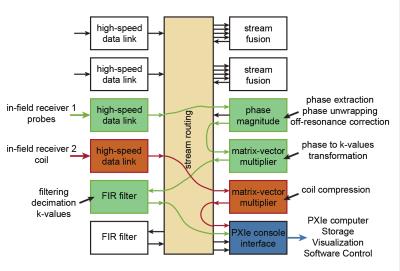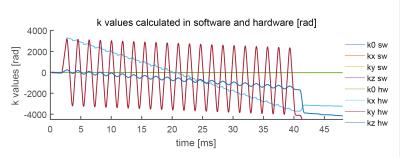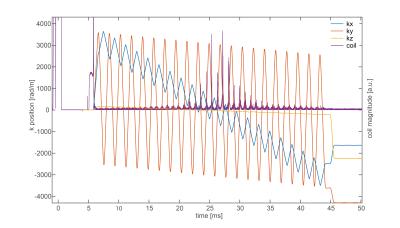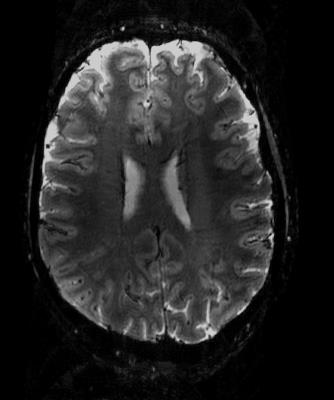2689
Distributed receivers with hardware-accelerated signal processing: Synchronous acquisition of image data and k-space trajectories1University and ETH Zurich, Zurich, Switzerland
Synopsis
The demand for higher image quality led to a significant increase in the number of parallel receive coils and to the addition of sensor systems such as magnetic field monitoring probes to MR systems, boosting the demand for many high quality receive channels. Furthermore, new methods increasingly require high acquisition duty cycles and bandwidths setting new requirements on data traffic and real-time capabilities. We present a flexible, scalable receiver system addressing those issues demonstrated on an example of concurrent imaging and field monitoring with real-time processing of synchronized streams of coil and trajectory data, as required by modern reconstruction algorithms.
Introduction
The continuous demand for higher image quality and shorter scan time led to a significant increase in the number of parallel receive array coils and therefore channels in modern MR spectrometers. Additionally, MR systems are increasingly complemented with sensor systems such as field probes for trajectory monitoring [1,2], prospective motion tracking [3] and field stabilization [4], which require additional RF channels, generate additional data traffic and set higher requirements on real-time capabilities. Furthermore, several new methods, such as single shot read-outs or zero echo time imaging (ZTE) require high acquisition duty cycles and bandwidths [5].
These demands call for new spectrometer architectures, which are flexible, scalable and provide configurable real-time data pre-processing pipelines beyond capabilities of today’s CPUs.
In this work, we present an integrated receiver, which addresses these challenges. It is based on a scalable, modular design consisting of fiber-optically attached in-field receiver modules [6] and receiver console with configurable real-time data processing capabilities.
The functionality is demonstrated on an example of concurrent imaging and field monitoring. Thereby the field monitoring data is processed in real-time on the console resulting in consistent, synchronized streams of coil and trajectory data, as required by non-Cartesian image reconstruction algorithms.
Methods
The receiver system incorporates up to four high dynamic range, broadband, 16-channel in-field receiver modules [6] connected via fiber optics to a receiver console in the control room. The synchronicity of the modules is guaranteed as they are supplied with the same stable clock reference from the receiver console.
The core building block of the receiver console is a Zynq SoC (Xilinx, San Jose, USA) which runs data stream based signal processing architecture on a FPGA. All channels of a stream share the same 32-bit wide bus and can be flexibly routed from the high-speed data link through the desired signal processing blocks and finally to a PXIe based computer for data storage and visualization. The routing and functionality of the signal processing blocks is freely controlled via software at run time. Several building blocks have been implemented for performing matrix-vector multiplication, phase and magnitude extraction, phase unwrapping and off-resonance correction, FIR filtering and decimation.
For demonstration, the processing blocks were configured for field probe data processing according to [2], consisting of: phase extraction, unwrapping, off-resonance correction, basis transformation (matrix-vector multiplication) for k-space coefficient extraction, filtering and decimation.
The data has been acquired using two in-field modules connected to a 16-channel human head coil (Nova Medical, Willmington, MA, USA) and a 16-channel T/R Box. 19F probes (Skope MRT, Zurich, Switzerland) field probes were used for trajectory monitoring, allowing for a spatial field expansion on a full 3rd-order spherical harmonic basis. While all terms were fitted, only the 1st-order coefficients were used in the image reconstruction. Even though the bandwidth occupied by the field probe signals spans up to 1 MHz for, the actual bandwidth of the gradient switching and hence of the phase evolution of the probe signal is below 50 kHz, allowing for phase or k-space coefficient decimation. A decimation factor of 16 was employed.
The experiment was performed on a 7 T human scanner (Phillips Healthcare, Cleveland, OH, USA).
Results
The streaming architecture supports full duty-cycle acquisitions and can pipe up to 156.25 MSps per stream through the modules for up to 32 channels.
An EPI sequence was monitored and k-values were calculated in the FPGA resulting in an overall data reduction factor of 64 without loss of information. A concurrent raw data stream showed a minor numerical precision difference (< 1 ppm) for calculations in software.
A 5 interleaves EPI image has been reconstructed using concurrent monitoring and coil data from two in-field modules demonstrating precise synchronicity of the two modules.
Discussion
The presented modular and scalable receiver system offers a large number of highly synchronous receive channels whose acquisition parameters (center frequency, bandwidth etc.) and real-time data processing can be configured in run-time. This enables e.g. concurrent acquisition of imaging and field monitoring and performing the first computationally intensive steps of the reconstruction in real-time on the receiver’s hardware. The amount of generated data and thereby the throughput requirements are significantly reduced without loss flexibility and information. In this way, the host computer is significantly offloaded and the subsequent reconstruction is accelerated by the reduction of input data and processing steps. Furthermore, the latency of real-time computations can be drastically shortened by the presented embedded computing which is required for e.g. prospective navigators, motion correction [3] and field feedback [4].Acknowledgements
No acknowledgement found.References
[1] De Zanche N., et al. NMR Probes for measuring magnetic fields and field dynamics in MR system. MRM 2008:60(1):176-186
[2] Barmet C., et.al. Spatiotemporal Magnetic Field Monitoring for MR. MRM 2008:60(1):187-197
[3] Haeberlin M, et al. Real-time motion correction using gradient tones and head-mounted NMR field probes. MRM 2015:74(3), 647-660
[4] Duerst Y, et al. Real-time feedback for spatiotemporal field stabilization in MR systems MRM 2015:73(2), 884-893
[5] Weiger M, et al. ZTE imaging in humans. MRM 2013:70(2), 328-332
[6] Reber, et al. In-Bore Broadband Array Receivers with Optical Transmission. Proc. ISMRM 2014
[7] Marjanovic, et al. An FPGA Based Real-Time Data Processing Structure – Application to Real-Time Array Coil Data Compression. Proc. ISMRM 2016
Figures



